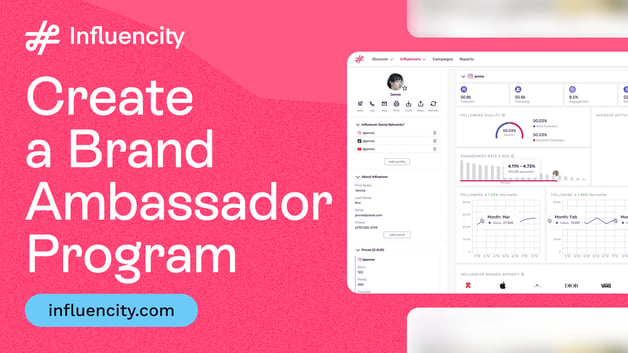How to Measure Influencer Marketing Success: KPIs, Metrics & ROI
Understanding how to measure the impact of your influencer marketing efforts can help you make informed decisions, optimize your campaigns, and allocate your resources more effectively. By tracking key performance indicators (KPIs) such as engagement rates, click-through rates, and conversion rates, you can gain valuable insights into the impact of your brand messaging and ensure you are achieving desired results.
In today’s post, we will break down the essential KPIs and metrics that you should be measuring on a regular basis in order to determine the ROI of your influencer marketing campaigns.
What Are Key Performance Indicators (KPIs)?
In the context of influencer marketing, Key Performance Indicators (KPIs) refer to specific metrics and data points that brands can use to measure the performance and effectiveness of their influencer marketing campaigns. These KPIs help businesses assess the impact of their influencer collaborations, measure the reach and engagement of their target audience, and understand the overall return on investment (ROI) generated through these partnerships. By focusing on these key metrics, businesses can make informed decisions, optimize their influencer strategies, and maximize the success of their marketing efforts.
Common Influencer Marketing KPIs
Here are some of the essential KPIs that you should be tracking on a regular basis to measure the impact of your influencer marketing campaigns:
- Reach and impressions. This KPI measures the total number of individuals who have been exposed to an influencer's content. It provides insights into a campaign's potential reach and the overall visibility of the brand among the target audience.
- Engagement rates. Tracking engagement metrics, which take into account campaign likes, comments, and shares, helps determine the level of interaction and interest generated by an influencer's content. High engagement rates indicate that the content is resonating well with the target audience and driving meaningful conversations.
- Follower growth. Monitoring changes in a brand’s follower count before, during, and after a campaign can indicate the effectiveness of the collaboration in attracting and retaining the audience's interest. It also provides insights into the long-term impact of the influencer's endorsement on brand visibility.
- Click-through rates (CTR). Evaluating the number of clicks on links shared by an influencer helps measure the level of interest and intent among the audience to explore the brand further. This KPI is particularly useful in assessing a campaign's effectiveness in driving traffic to the brand's website or specific landing pages.
- Conversions and sales. Tracking the number of conversions and sales attributed to an influencer's content provides a direct measure of a campaign's impact on the brand's bottom line. Using trackable links, promo codes, or specific landing pages can help accurately attribute conversions and sales to the influencer's efforts.
How to Measure Influencer Marketing KPIs, Metrics, & ROI
In this section, we will take a look at the essential tools and strategies that you can use to measure influencer marketing KPIs, metrics, and overall ROI. That way, you can track your results with confidence, make informed decisions, and ensure that your campaigns not only resonate with your audience but also deliver tangible and measurable value to your brand.
Define Clear Goals and Objectives
Clearly define the objectives of your influencer marketing campaign, whether it's to increase brand awareness, drive sales, or improve brand perception. These goals will serve as a foundation for selecting relevant KPIs and metrics for measuring the performance of your influencer marketing campaigns.
Identify Key Performance Indicators (KPIs)
The next step is identifying relevant KPIs for measuring your influencer marketing campaigns in line with your defined objectives. Consider KPIs such as reach and impressions, engagement rates, follower growth, click-through rates, sales, and conversions to gain a comprehensive understanding of your campaign's impact. These key metrics serve as benchmarks, allowing you to assess the effectiveness of your influencer collaborations and tailor your strategies to achieve optimal results.
Use Advanced Analytics Tools
Use advanced analytics tools and platforms that can accurately measure and analyze your selected KPIs. For example, Influencity's platform is a powerful tool that can be used to comprehensively measure and analyze your defined influencer marketing KPIs. The platform offers a range of advanced analytics features that provide valuable insights into an audience's behavior, preferences, and engagement with the influencer's content and your brand.
Track and Monitor Campaign Performance
Consistently monitor campaign performance in real time to identify any emerging trends or issues. Keep a close eye on your selected KPIs to understand how the campaign is performing and whether it is meeting your defined objectives.
Implement Trackable Links and Promo Codes
Implement trackable links and unique promo codes in the influencer's content to accurately attribute conversions and sales to the campaign. These tracking mechanisms can provide valuable data for calculating the campaign's return on investment (ROI).
Calculate Return on Investment (ROI)
Calculate the return on your investment by comparing the revenue generated from the campaign to your total investment. Consider all the costs associated with the campaign, including influencer fees, content creation, and distribution.
There are several ways to calculate influencer marketing ROI. One common method is to use the following formula:
ROI = (Revenue/Cost) x 100
For example, if an influencer marketing campaign generates $20,000 in revenue and costs $5,000, the calculation would be:
ROI = ($20,000 / $5,000) x 100 = 400%
This means that for every $1 invested, the campaign generated $4 in revenue. This is an excellent result, indicating a highly successful campaign.
Regularly Optimize Your Strategies
Finally, and arguably most importantly, make sure you regularly optimize your influencer marketing strategies in line with your influencer marketing KPI measurements to enhance campaign performance and achieve better results. By continuously optimizing your campaigns in line with this data, you can maximize your return on investment and achieve long-term success for your brand.
Tags:






















%20and%20How%20Can%20They%20Benefit%20Your%20Brand%20article.jpg?length=628&name=What%20Are%20Key%20Opinion%20Leaders%20(KOL)%20and%20How%20Can%20They%20Benefit%20Your%20Brand%20article.jpg)








